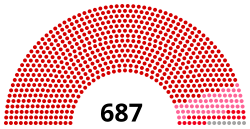Supreme People's Assembly 최고인민회의 最高人民會議 Ch'oego Inmin Hoeŭi | |
|---|---|
| 14th Supreme People's Assembly | |
 | |
| Type | |
| Type | |
| Leadership | |
| Structure | |
| Seats | 687 |
 | |
Political groups |
|
| Committees |
|
| Elections | |
| Approval voting for single party-nominated candidate | |
Last election | 10 March 2019 |
| Meeting place | |
 | |
| Mansudae Assembly Hall Pyongyang Democratic People's Republic of Korea | |
| Chosŏn'gŭl | |
|---|---|
| Hancha | |
| Revised Romanization | Choego Inmin Hoeui |
| McCune–Reischauer | Ch'oego Inmin Hoeŭi |
 |
|---|
|
|
The Supreme People's Assembly (SPA; Korean: 최고인민회의; MR: Ch'oego Inmin Hoeŭi) is the legislature of North Korea. It is ostensibly the highest organ of state power and the only branch of government in North Korea, with all state organs subservient to it under the principle of unified power. However, in practice it is a rubber stamp legislature which exists to approve decisions made by the ruling party as a formality, and which has little to no real power of its own.[1][2]
It consists of one deputy from each of North Korea's 687 constituencies,[3] elected to five-year terms.[4]
The constitution identifies the SPA as the "highest organ of state power" and all state positions, including the President of the State Affairs and in theory the Premier of the Cabinet, trace their authority to it. The Assembly typically does not legislate directly but delegates that task to a smaller Standing Committee. Government officials carry out the policies legislated by the SPA subject to oversight and correction by the Workers' Party of Korea. [citation needed]
The Workers' Party of Korea, which the constitution recognizes as the state's leading party, dominates the Assembly in a monopoly coalition with the Social Democratic Party and the Chondoist Chongu Party called the Democratic Front for the Reunification of Korea. Elections are held in five-year intervals, the most recent in 2019.
- ^ North Koreans vote in 'no-choice' parliamentary elections
- ^ North Korea goes to polls to rubber-stamp parliament lineup
- ^ "DEMOCRATIC PEOPLE'S REPUBLIC OF KOREA Choe Go In Min Hoe Ui (Supreme People's Assembly)". Inter-Parliamentary Union. 5 August 2014. Retrieved 3 January 2018.
- ^ "DPRK Holds Election of Local and National Assemblies". People's Korea. Archived from the original on 2012-05-10. Retrieved 2008-06-28.